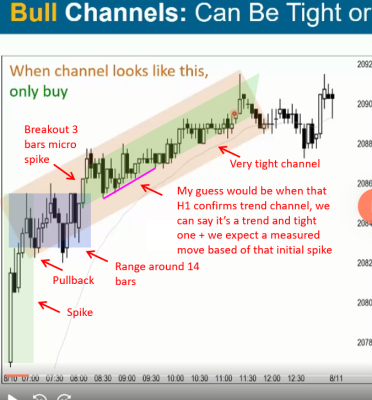The support forum is built with (1) General and FAQ forums for common trading queries received from aspiring and experienced traders, and (2) forums for course video topics. How to Trade Price Action and How to Trade Forex Price Action videos are consolidated into common forums.
Brooks Trading Course social media communities
Al says, "When a channel looks like this, it's a breakout on a higher time frame chart. Only look to buy" for Tight Bull Channel.
But he is saying this by showing almost the entire channel. In the beginning of the channel, as the bars are forming, we may not know if it's going to be tight or not. So, the question is, how long should we wait to decide that the channel is tight (in real time)?
Hi Raghavendra,
You'll probably want to begin by waiting for a breakout (either one big bar or CC strong trend bars) since most of the tight channels are essentially part of spike+CH formations. You can already enter on a BO itself if it supports the context such as with trend resumption after a PB or MTR (but not climactic exhaustion after a trend that already went for a long time).
Then comes the pullback and you'll want it to be weak such as when bulls in a bull BO keeping breakout gap open as a micro gap or at least as a bodygap, so that you can buy when the PB ends. Sometimes it's possible to buy above the BO right away after a PB that lasts only a single bar ends or maybe even buying the reversal attempt with limits if it's weak (advanced).
Once the move resumes after a PB it's likely to be forming the tight channel, so you'll want to observe the steepness. Steep tight channels are often created when PBs can't do more than a single leg PB. If a PB goes on for more than 1 leg it usually widens the channel and makes it flatter. A steep channel often has only 1 or 2 bar pullbacks that are immediately faded.
After that you'll want to observe how many legs a channel accumulates. After 3 legs (or even after 2 legs) Al advises caution because of possible wedges.
Even if a channel has accumulated 3 legs, if it's very tight and there are no signs of exhaustion yet and it's not at any particular S/R, the first break of a tight channel is more likely to be minor so there are still opportunities to enter with trend (possibly may require scale in).
So to summarize, everything starts with a breakout because as per the market cycle it should lead to a channel after a PB, so that would be the earliest sign to look for, assuming the context is right.
Hope that helps,
CH
__________________
BPA Telegram Group
Thanks, Mike and CH for your valuable insight.
So, if I am able to enter during Spike, I would monitor the channel and apply all the rules to decide if it is tight, which would help in deciding the exit (avoid early exits).
If for some reason cannot enter during spike, then the first PB is the crux, which helps in deciding the tightness and thus the entry.

